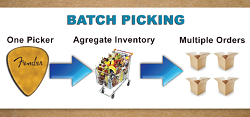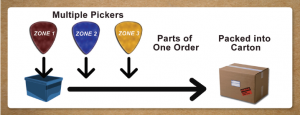Wave Picking and Warehouse Management System (WMS) Basics
The Basics of Wave Picking and Warehouse Management Systems (WMS) Every distribution company knows the importance of operational efficiency when it...

Growing distribution centers (DCs) are well aware of the two constant challenges to achieve both productivity and accuracy in fulfillment. As the Amazon model begins to make every company a multi-channel fulfillment company, knowing if you are picking the right order or, more importantly, picking the order in the right way becomes an important determinant in the overall productivity of your operations.
In our previous two blogs,we covered the basics of wave picking and discrete picking.
Batch picking allows the picker to collect all the products required in a wave (a group of orders) before packing them into cartons. For each pick, you are guided to the pick bin, and told the product and quantity to pick, but not the cartons into which to pack the items. Instead, you place the products in aggregate onto a pallet, cart, or into totes and bring them to a sorting area where you then segregate them into cartons for the appropriate orders.
The benefit of this wave picking method that it fits best when a warehouse layout that is not designed for bringing cartons through aisles of pick bins. It is also an efficient way to pick a large number of orders (each with a few lines), as it lets you split the picking and packing functions between two people.
When planning a Batch Pick process, consideration must be given to pack station space and configuration. At the pack station, the pack operators will be breaking down the batch of inventory into discrete orders (this is often referred to as a secondary pick) so there should be adequate space and equipment to support the inventory and handling. Similar to Wave Picking, the primary benefit of batch picking is reduced travel time associated per order. However, process benefits should also factor in the increased space and labor required to perform the secondary pick process at the pack stations. Pick labor versus pack labor is the balance to measure when Batch Picking.
Learn more about critical features to consider when upgrading to a Warehouse Management System
Posted by iCepts Technology Group, Inc. An Accelos and Microsoft Dynamics NAV Partner in Pennsylvania
We are a Microsoft Dynamics NAV Partner offering implementation, service, and support for Microsoft Dynamics NAV in: PA, DC, DE, MD, NC, NJ, NY, OH, VA, WV, and the entire Mid-Atlantic Region. We also offer implementation, service, and support for Accellos One Warehouse Management Systems in: PA, DC, DE, MD, NC, NJ, NY, OH, VA, WV, and the entire Mid-Atlantic Region.
As experienced SCM, WMS and ERP consultants and value added resellers (VARs), we provide start to finish services for the solutions we represent Microsoft Dynamics NAV for Distribution and Manufacturing, Accellos Warehouse Management System (WMS), Server virtualization, open source VOIP phone systems and infrastructure and security. We provide services that cover process analysis, implementation, training, security and networking. Naturally, we also provide full ongoing support for years after implementation to help our clients succeed. We are your one stop shop for your business technology needs.
Contact us for additional information by clicking HERE or give us a call or send a note:
Phone: 717.704.1000
Email: info@icepts.com
Another version of this article was previously posted by iCepts Technology Group, Inc.- A Pennsylvania Microsoft Dynamics NAV Reseller on August 25,2016 - Warehouse Management Basics Batch Picking

The Basics of Wave Picking and Warehouse Management Systems (WMS) Every distribution company knows the importance of operational efficiency when it...

Warehouse Management Systems (WMS) – Two Types of Zone Picking and the Basics Today’s distribution centers (DC) understand the importance of...

Discrete Picking and Your Warehouse Management System (WMS) As your business grows, maintaining productivity while also keeping accurate inventory...